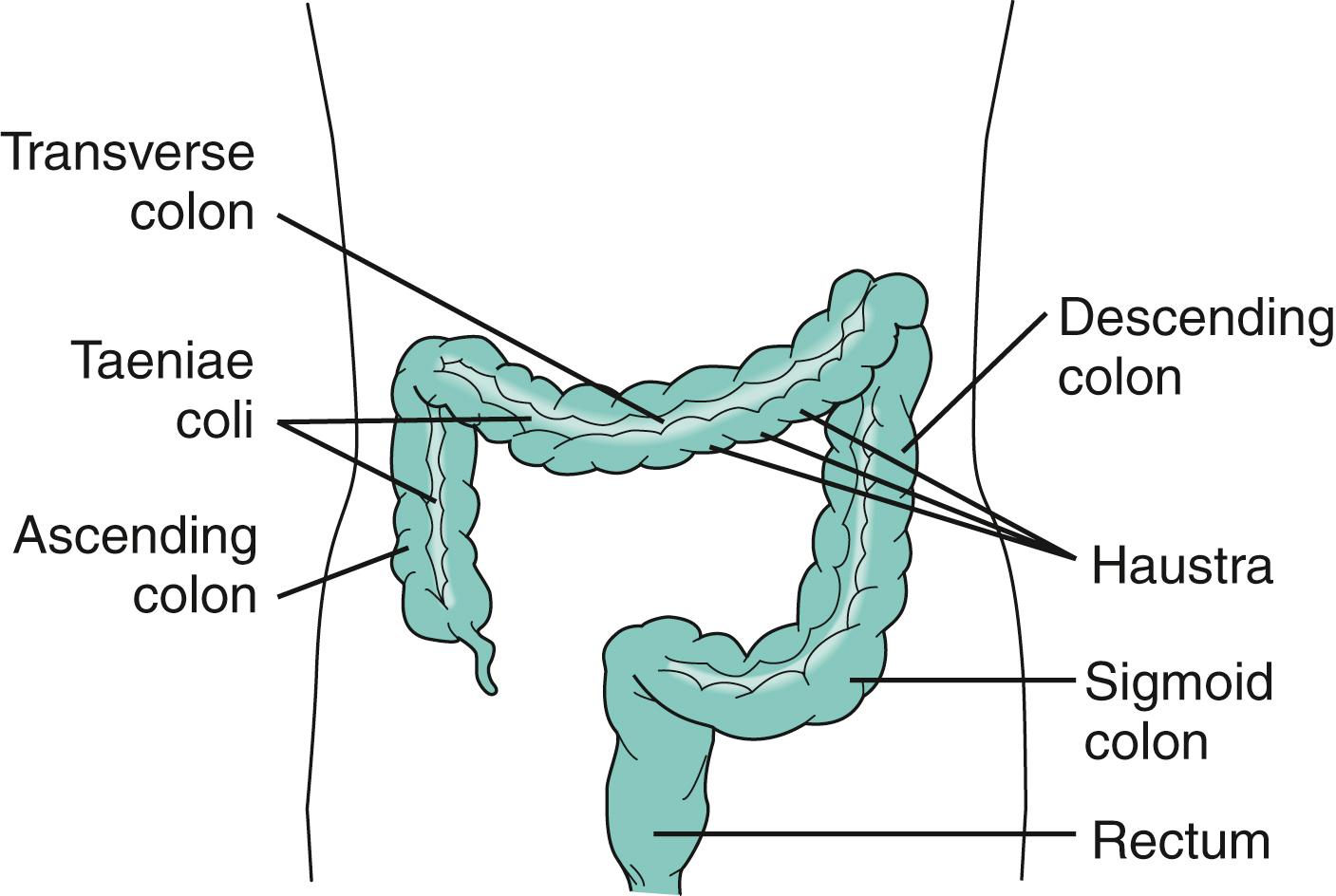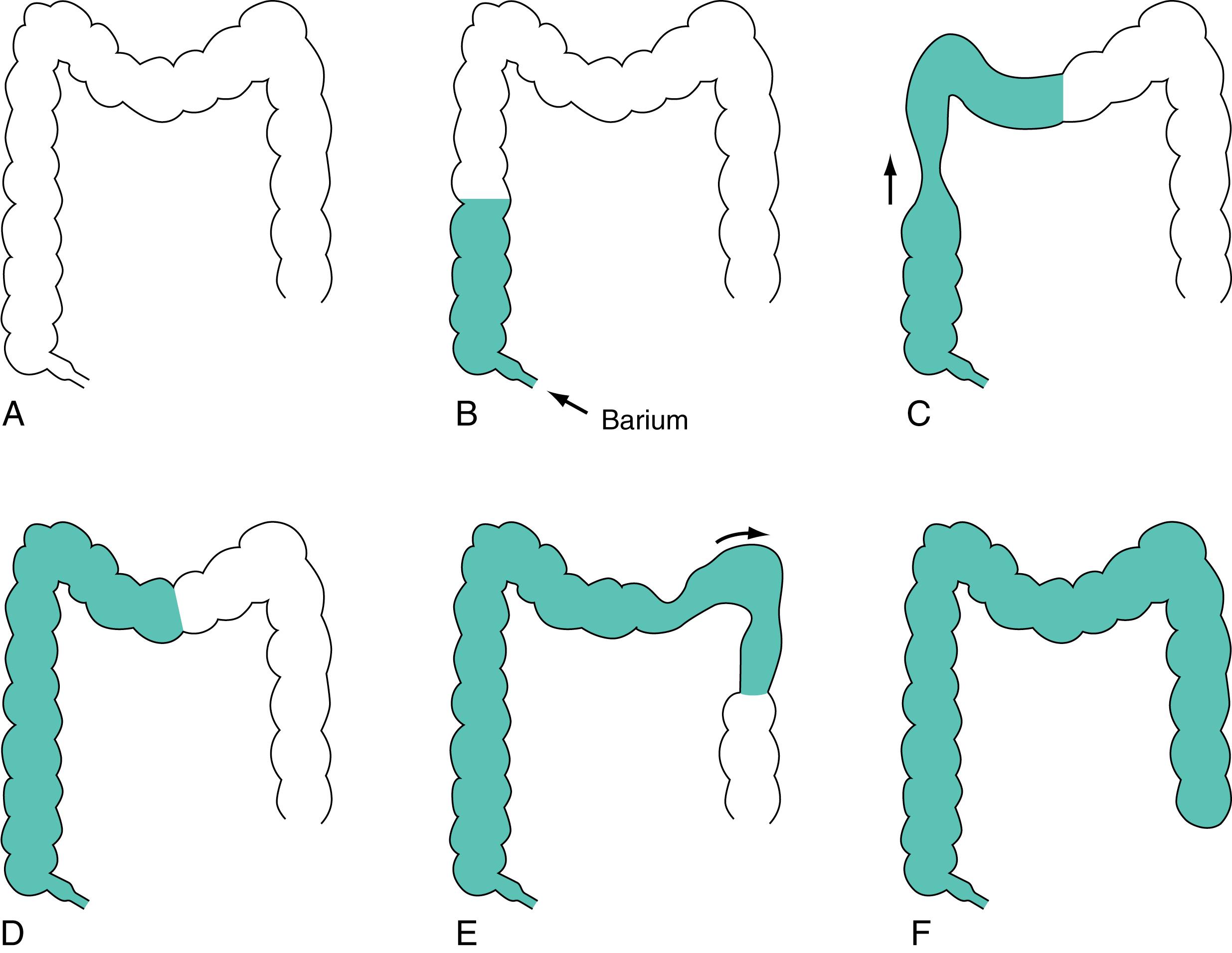Physical Address
304 North Cardinal St.
Dorchester Center, MA 02124
Describe the anatomy of the large intestine.
Explain the function of the ileocecal reflex.
Define a mass movement.
Understand the motility of defecation and the rectosphincteric reflex.
Discuss the control of defecation and explain the loss of control that occurs with some spinal cord injuries.
Contractions of the large intestine are organized to allow for optimal absorption of water and electrolytes, net aboral movement of contents, and storage and orderly evacuation of feces.
Anatomically the human large intestine is divided into the following: the cecum ; the ascending , transverse , descending , and sigmoid colon ; the rectum ; and the anal canal . The muscular layers of the large intestine are composed of both longitudinally and circularly arranged fibers. Longitudinal fibers are concentrated into three flat bands called the taeniae coli . These run from the cecum to the rectum, where the fibers fan out to form a more continuous longitudinal coat. The circular layer of muscle fibers is continuous from the cecum to the anal canal, where it increases in thickness to form the internal anal sphincter . Overlapping and slightly distal to the internal anal sphincter are layers of striated muscle. These striated muscle bundles make up the external anal sphincter .
In humans the external features of the large intestine differ from those of the small intestine. In addition to the presence of taeniae coli, the colon appears to be divided into segments called haustra or haustrations ( Fig. 6.1 ). Haustra probably are the result of structural and functional properties of the colon. Points of concentration of muscular tissue and mucosal foldings can be found in colons examined post mortem.

In addition, haustra are more prominent in areas of the colon that possess taeniae coli. Haustra are not fixed, however. Segmental colonic contractions appear, disappear, and form again at another locus. Thus haustral formation also has a dynamic component because of the contractile activity of colonic musculature.
The large intestine, like other areas of the bowel, is innervated by the autonomic nervous system (ANS). The enteric system consists partly of many nerve cell bodies and endings that lie between the circular and the longitudinal muscle coats. In areas of the large intestine with taeniae, this myenteric plexus is concentrated beneath them. Cells of the myenteric plexus receive input from a variety of receptors within the intestine, as well as by way of the extrinsic nerves. Axons from these cells innervate the muscle layers. Extrinsic innervation to the large intestine comes from both parasympathetic and sympathetic branches of the ANS. There are two pathways of parasympathetic innervation: the cecum and the ascending and transverse portions of the colon are innervated by the vagus nerve; the descending and sigmoid areas of the colon and the rectum are innervated by pelvic nerves from the sacral region of the spinal cord. The pelvic nerves enter the colon near the rectosigmoid junction and project orally and aborally within the plane of the myenteric plexus. These projections, called shunt fascicles , innervate myenteric nerves en route. The vagus and pelvic nerves consist primarily of preganglionic efferent fibers and many afferent fibers. The efferent fibers synapse with the nerve cell bodies of the myenteric and other intrinsic plexuses. The proximal regions of the large intestine are sympathetically innervated by fibers that originate from the superior mesenteric ganglion. More distal regions receive input from the inferior mesenteric ganglion. The distal rectum and anal canal are innervated by sympathetic fibers from the hypogastric plexus. Most of the sympathetic fibers are postganglionic efferent and afferent fibers. The external anal sphincter, a striated muscle, is innervated by the somatic pudendal nerves.
As in other regions of the gut, several diverse chemicals serve as mediators at presynaptic and postsynaptic junctions within the autonomic innervation to the large intestine. Acetylcholine (ACh) and tachykinins such as substance P serve as major excitatory mediators, and nitric oxide (NO), vasoactive intestinal peptide (VIP), and possibly adenosine triphosphate (ATP) serve as major inhibitory mediators. Transmission between the pudendal nerves and the external anal sphincter is mediated by ACh.
The flow of contents from the small intestine into the large intestine is intermittent and is regulated partly by a sphincteric mechanism at the ileocecal junction . A sensor placed in the junction records pressures that are several millimeters of mercury (mm Hg) greater than those in the ileum or colon. The pressure is not constant, however; the sphincter relaxes periodically, and during this time ileal contractions propel contents into the large intestine ( Fig. 6.2A ). Once material reaches the proximal large intestine, it is acted on by a wide variety of contractions. Most of these contractions are segmental, with durations of 12 to 60 seconds. The pressures generated by these contractions vary in amplitude, ranging between approximately 10 and 50 mm Hg.

It is believed that these contractions are partly responsible for the haustrations seen in the colon. At adjacent sites, contractions usually occur independently. Thus they slowly move the contents back and forth, mixing and exposing them to the mucosa for absorption of water and electrolytes. In addition to pressure changes caused by segmental contractions, many of other pressure waves have been recorded. Attempts to classify these have been made, but the degree of overlap of pressure profiles makes classification difficult.
Occasionally, segmental contractions are organized in an oral-to-aboral direction; thus propulsion over short distances takes place. Usually, however, propulsion occurs during a characteristic sequence termed mass movement . Segmental activity suddenly ceases, and along with its disappearance is a loss of haustrations. The colon then undergoes a contraction that sweeps intraluminal contents in an aboral direction ( Fig. 6.3A to C). After the mass movement, haustrations and phasic contractions return ( Fig. 6.3D ). Mass movements are infrequent in healthy people and are estimated to occur only one to three times daily. Because they are such infrequent events, they have not been studied in any great detail in normal persons.

Become a Clinical Tree membership for Full access and enjoy Unlimited articles
If you are a member. Log in here